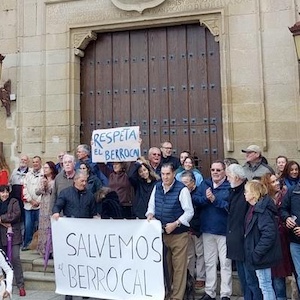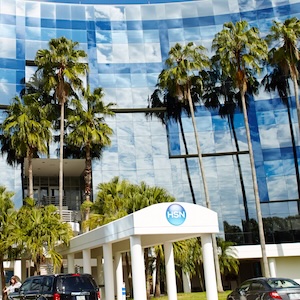
Residents of Trujillo, Spain, last week protested the planned installation of 22 high-voltage towers meant to power Diamond Foundry’s factory, claiming they will be an eyesore and hurt a historic area called El Berrocal—which translates to “rocky place.”
“El Berrocal is a natural space of granite rock formations very characteristic of the region, where there are many remains of primitive settlements that existed in the area, as well as being a very beautiful landscape and a natural area rich in animal species, mainly birds,” a spokesperson for Plataforma Cívica El Berrocal, a group that opposes the towers’ construction, tells JCK. “In this environment there are hardly any modern constructions, so on the horizon you can contemplate the best views of the medieval city of Trujillo, with its walls of the 10th century.”
The protesters called for an alternative to the 131-foot-tall towers. “Imagine the visual impact of building 22 metal towers 40 meters high at a distance of a few tens of meters from the wall. This will ruin the landscape and have a very negative impact on the natural environment,” the spokesperson says.
Diamond Foundry CEO Martin Roscheisen responds: “There is an issue with one of the poles in our five-kilometer power line that people don’t like. We are working to find ways to improve this. The power line is the result of a two-year administrative and planning process with all levels of government and many stages of public comment.”
Rafael Benjumea, head of Diamond Foundry in Spain, told local officials last week that the company wants to collaborate on finding a solution to the issue, according to local newspaper Hoy Trujillo.
“If there are problems, let’s sit down because we have never refused to talk to anyone. Let’s not give an external image of confrontation [to] a project of this importance,” he said. “If we cannot have a solution in the very short term, of course our willingness to work for Trujillo in the medium and long term is absolute.”
The spokesperson for Plataforma Cívica El Berrocal was not assuaged. “They [say] it will be very difficult to achieve a solution in the short or medium term. They want to try to convince the population that it is necessary to build the electric line this way at the beginning, and that later they will commit to solving the problem. We believe that these are promises to save face and meet deadlines and costs. It is in a way an attempt at deception.”
The spokesperson stresses that the protesters do not oppose “the construction of the synthetic-diamond factory in our city. We consider it an opportunity for the economic development of the city and to generate employment. We only ask Diamond Foundry and the politicians to reach an agreement to change the route of the power lines, so that it does not cause such serious damage to our environment and our heritage. We want the factory, but we ask that they do things right and that the city be respected.”
Diamond Foundry has received approval from the local government and is due to begin production at the Trujillo facility next May.
In his reported comments, Benjumea urged people to read the environmental impact report that the regional government issued earlier this year about the Diamond Foundry plant.
That report concluded that “the completion of the project and its startup will [not] produce significant effects on the environment, provided that the conditions and preventive, corrective, and compensatory measures…are met.”
Concerns listed by the study included methane emissions, which it estimated at a possible 70,000 kg a year.
“It would be good to coordinate with other companies that are dedicated to the use of methane and even with universities, since progress is already being made in the use of methane from macro farms and mines,” the report said. “On the other hand, the equivalent metric tons of carbon dioxide could be balanced with the planting of equivalent trees in various reforestation campaigns, in order to meet the requirement of zero energy balance and closed waste cycle.”
David Bonnardeaux, director of environment, climate, and energy for PACT, the international development NGO, calls the methane number “relatively high” and says those emissions should be mitigated or, optimally, captured and repurposed.
“Offsetting it via reforestation would not pass muster, to be honest,” says Bonnardeaux, “given the scrutiny being imposed on offsets these days. That said, if they were to ‘inset’ within the municipality itself, and had a good monitoring, reporting, and verification system in place to ensure the permanence of the reforestation, then it could fly.”
The factory will also use a large amount of water, estimated at 736,1620 cubic meters a year. Total water use in Trujillo was approximately 650,000 cubic meters in 2018.
It’s “highly concerning that it would consume more water than the whole Trujillo population,” says Bonnardeaux. “There is a need to assess whether the Santa Lucia reservoir can assimilate that annual water abstraction without jeopardizing the water needs of human population as well as environmental flows.”
He notes that the study mentions reusing treated wastewater for cooling towers, toilets, and cleaning of factory facilities.
Roscheisen tells JCK: “There are no environmental issues outstanding.”
Diamond Foundry recently revamped its website to emphasize tech applications for lab-grown diamonds. Tech-oriented products are expected to be a focus of the Spanish factory. The company just announced that it had created the world’s first 100 mm single-crystal diamond wafer, which it called the “largest diamond on Earth.”
Roscheisen says the company will produce 5 million carats of lab-grown diamonds by the end of 2023. That will ramp up to 20 million carats by the end of 2024, as the facility in Spain begins production. Diamond Foundry also produces diamonds at a factory in Wenatchee, Wash.
Top: A protest against the towers last week (Photo courtesy of Plataforma Cívica El Berrocal)
- Subscribe to the JCK News Daily
- Subscribe to the JCK Special Report
- Follow JCK on Instagram: @jckmagazine
- Follow JCK on X: @jckmagazine
- Follow JCK on Facebook: @jckmagazine







